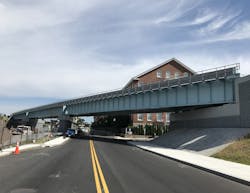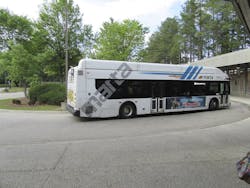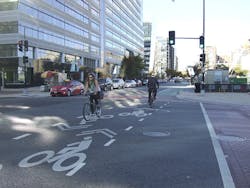Examining public transportation systems through an equity lens
Equity in public transportation is not new. Building equitable infrastructure has been an important part of transportation network planning and design for many years.
Over the last few years, however, equity in the built environment has shifted from simply minimizing adverse impacts to a more comprehensive strategy of balancing potential negative impacts with the purposeful incorporation of benefits that positively impact all affected populations. This heightened awareness is due in part to increased focus across our industry and the federal government placing greater emphasis on sustainability and equity—aligning equity with critical funding for transportation projects.
For example, the American Rescue Plan, aimed at helping individuals, businesses, and communities adversely impacted by the COVID-19 pandemic, allocates $30.5 billion for public transportation systems. The Infrastructure Investment and Jobs Act (IIJA)—recently signed into law by President Biden—is a $1 trillion infrastructure bill that includes funding to fix, rebuild, and upgrade America’s highways, bridges, airports, ports, and transit systems—with an emphasis on equitable transportation options. And, in November, U.S. Secretary of Transportation Pete Buttigieg announced $1 billion in project investments through Rebuilding American Infrastructure with Sustainability and Equity (RAISE) grants. The program aims to modernize and create new transportation infrastructure that is equitable for all Americans.
Multimodal public transportation options—from buses, subways, light rail, and streetcars to water taxis, van pools, e-bikes, and scooters—are a lifeline to education, employment, healthcare, and entertainment. Public transportation is more than just a means of getting from Point A to Point B; it provides accessibility and critical community connections—essential for all riders in all neighborhoods to live productive lives. The AEC industry, including transportation and transit agencies, has a renewed and elevated focus on the impacts infrastructure and transportation projects have, keeping equity at the forefront of decision-making and planning as projects advance.
Restoring Service & Renewing Opportunity in Massachusetts
In Southeastern Massachusetts, rail service restoration was decades in the making. Fall River, New Bedford, and Taunton are the only major cities within 50 miles of Boston without commuter rail access to the Commonwealth capital. The Massachusetts Bay Transportation Authority’s South Coast Rail project (SCR) will establish new commuter rail service to previously underserved communities, providing improved access and better connectivity to major metropolitan centers, thereby creating job opportunities and stimulating the local economy.
Currently one of the largest projects in Massachusetts, the $1.14 billion first phase of the SCR program includes 37 miles of track and railbed; signals and communications infrastructure; six new stations; 28 at-grade crossings; 14 bridges; two layover facilities; miles of retaining wall and drainage upgrades; and mitigation and utility modifications. SCR is an important step towards increasing transportation equity in the Commonwealth, with rail service restoration helping to make the communities of the South Coast economically competitive with the rest of the region by expanding job options and spurring economic development.
The MBTA expects passenger rail service to the South Coast region to begin in late 2023. Once complete, the project will restore passenger rail transportation to 31 communities from South Station in Boston, providing reliable transit service connecting the city center and Southeastern Massachusetts for the first time since the late 1950s.
Responding to Crisis in Atlanta
According to the American Public Transportation Association, Americans took 9.9 billion trips on public transportation in 2019. In the Atlanta region, transit services include bus, rail, and streetcar, all of which help to alleviate congestion on roadways, improve air quality, and provide more equitable access. The Metropolitan Atlanta Rapid Transit Authority (MARTA), the city’s principal public transportation operator, serves Fulton, DeKalb, and Clayton counties—three of the top five largest counties in Georgia—and understands the importance of bringing equitable transportation to all communities.
During the COVID-19 pandemic, transportation networks across the country were significantly impacted. Like many transit agencies, MARTA was simultaneously faced with a drastic drop in ridership and overcrowding on core bus routes. Their Essential Bus Service Plan considered the needs of a vulnerable, bus-dependent population, addressing 40 critical routes and one new circulator service that included lifeline transportation to 17 hospitals, 22 urgent care facilities, 85 grocery stores, and 16 job centers/industrial hubs. The plan allowed MARTA to provide safe, sustainable service during the height of the pandemic. Additionally, a prioritization framework was developed to bring suspended bus routes back online as quickly as possible. Key criteria included vulnerable populations, defined as persons of poverty, minorities, and senior citizens.
Another way MARTA is improving access to public transportation across the region is via new local transit (or mobility) hubs, which will aggregate and improve rider mobility options for bus travelers. Informed by various transit master plans, comprehensive transportation plans, and city planning visions and programs, these hubs aim to increase mobility options in the region, spur economic growth, promote social equity, and provide resilient transportation networks.
“MARTA is undertaking its most significant transit expansion and modernization program since its founding in 1971,” said Jeffrey A. Parker, General Manager & Chief Executive Officer at MARTA. “Our focus is on improving Atlanta transit through reliable, efficient, equitable service to our customers and communities.”
Reimaging Commutes in Washington, D.C.
Bicycle and pedestrian networks also play a critical role in public transportation networks. Biking or walking are less expensive, healthier options than automobiles—and are better for the environment due to less traffic congestion and fewer pollutant emissions. According to the U.S. Census Bureau via the League of American Bicyclists, 2019 saw more than 15,000 bicycle commuters in Washington, D.C., including the use of biking for last-mile transit connections.
In and around the nation’s capital, the Washington Metropolitan Area Transit Authority (Metro) is evaluating pedestrian and bicycle access at 46 Metrorail stations throughout the region. This Pedestrian and Bicycle Access Blueprint identifies conditions on Metro property that adversely impact customers walking and cycling, and recommends infrastructure improvements that Metro can undertake through its capital program. As part of this study, Metro examined how stations could be modified to attract pedestrians and cyclists through improved connections to the surrounding multimodal network, including bus planning and parking access.
Active transportation options, such as walking and biking, are increasingly becoming part of the reimagined commuting experience. Agencies like Metro are leveraging technology to help prioritize and design pedestrian and bicycle improvements across their network and increase station access. The data-driven approach uses existing travel demand model demographics, jurisdictional land use data, building layers, and the road network to estimate and predict the most critical segments for pedestrians approaching a station. Development of pedestrian and bike access design principles includes right-sizing facilities, incorporating wayfinding, and establishing safe and visible pathways for pedestrians and cyclists. The impacts of active transportation strategies can create lasting change to travel patterns and more equitable transportation access as agencies consider solutions for all modes and travelers.
As public agencies and their AEC consultant partners continue to examine more equitable transportation options, it is important to make certain that the infrastructure being built does not adversely—or positively—impact one community over another. Working together, with a focus on delivering solutions that provide fair access to mobility and transportation, we can positively transform public transportation in all communities.


